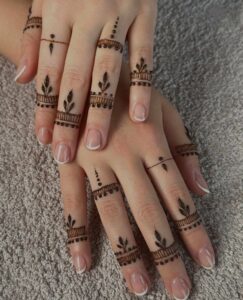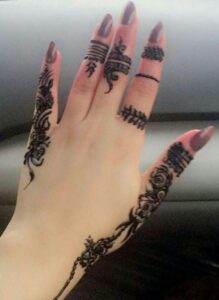Arabic Mehndi Design
Arabic Mehndi designs are celebrated for their graceful patterns, flowing aesthetics, and cultural richness. Originating from the Arabian Peninsula, these henna styles have captivated the hearts of women across South Asia, the Middle East, and even the West, where Arabic Mehndi Design is embraced in weddings, festivals, and special occasions.
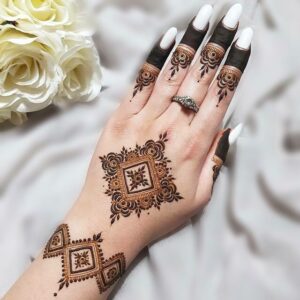
What Makes Arabic Mehndi Unique?
Unlike traditional Indian Mehndi, which often covers the entire hand with intricate, dense patterns, Arabic Mehndi is known for its bold outlines, floral motifs, and strategic use of negative space. The design typically flows diagonally across the hand, leaving parts of the skin visible to create contrast and elegance.
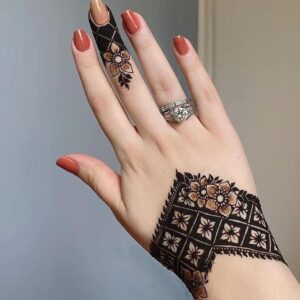
Key Features:
- Floral elements: Roses, vines, and leaves are common.
- Paisleys: A signature of Arabic style, representing life and eternity.
- Geometric touches: Subtle lines and dots to balance the natural motifs.
- Simplicity and speed: Easier to apply compared to heavily detailed Indian patterns.
Popular Occasions for Arabic Mehndi
Arabic Mehndi is versatile and suitable for both casual and festive events. It’s commonly worn during:
- Eid celebrations
- Weddings (brides or guests)
- Engagement ceremonies
- Henna nights
- Parties and cultural festivals
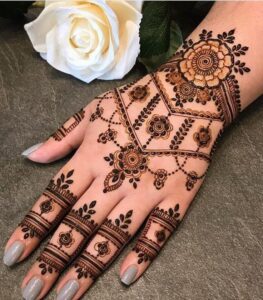
Styles of Arabic Mehndi
- Modern Minimalist – Sleek patterns with lots of open space.
- Bridal Arabic – More intricate, often merging Indian influences.
- Gulf-style Mehndi – Heavy on floral and leafy trails.
- Shaded Mehndi – Uses lighter strokes to add depth and texture.
FAQs about Arabic Mehndi Design
How long does Arabic Mehndi last?
Typically, Arabic Mehndi lasts 1 to 2 weeks, depending on skin type, aftercare, and the quality of henna used.
Is Arabic Mehndi suitable for beginners?
Yes! Arabic designs are perfect for beginners due to their simpler, spaced-out patterns.
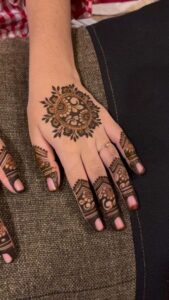
Can I apply Arabic Mehndi on my feet?
Absolutely. Arabic designs look elegant on both hands and feet, with slight modifications to suit the area.
How can I make the Mehndi color darker?
Apply lemon sugar syrup after the Mehndi dries, avoid washing hands for at least 6–8 hours, and keep your hands warm to enhance color.

Is Arabic Mehndi used only by Muslims?
While it has Arabic and Islamic origins, Mehndi transcends religious and cultural boundaries and is used by people across different traditions.

The Timeless Art of Henna that Bridges Tradition and Modernity
The delicate swirls and intricate patterns of mehndi have adorned hands and feet for over 5,000 years, creating temporary masterpieces that celebrate life’s most precious moments. This ancient art form, born from the henna plant’s natural dye, continues to evolve while honoring its rich cultural heritage. From traditional bridal ceremonies to contemporary fashion statements, mehndi designs offer a unique way to express creativity and connect with cultural traditions.
Understanding mehndi’s journey from ancient ritual to modern art form reveals why this beautiful practice remains relevant in our digital age. Whether you’re drawn to elaborate traditional patterns or prefer sleek contemporary designs, mehndi provides endless possibilities for personal expression.
The Cultural Tapestry of Mehndi
Mehndi holds deep cultural significance across many civilizations. In ancient Egypt, henna adorned the hands and feet of pharaohs before their journey to the afterlife. Middle Eastern cultures embraced mehndi as a symbol of joy and spiritual awakening, while South Asian traditions made it an essential part of wedding ceremonies and religious festivals.
The practice spread along ancient trade routes, with each culture adding unique elements to the art form. North African designs featured bold geometric patterns, while Indian styles developed intricate floral motifs. Pakistani mehndi incorporated architectural elements, and Arabic designs emphasized flowing, vine-like patterns with plenty of negative space.
Today, mehndi transcends cultural boundaries, with artists worldwide drawing inspiration from various traditions to create fusion designs that honor heritage while embracing contemporary aesthetics.

